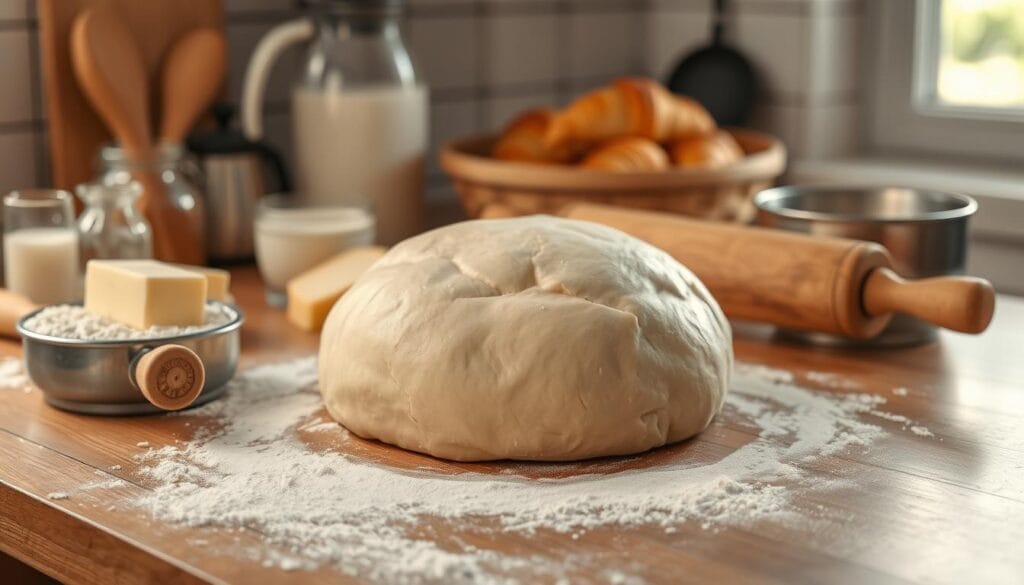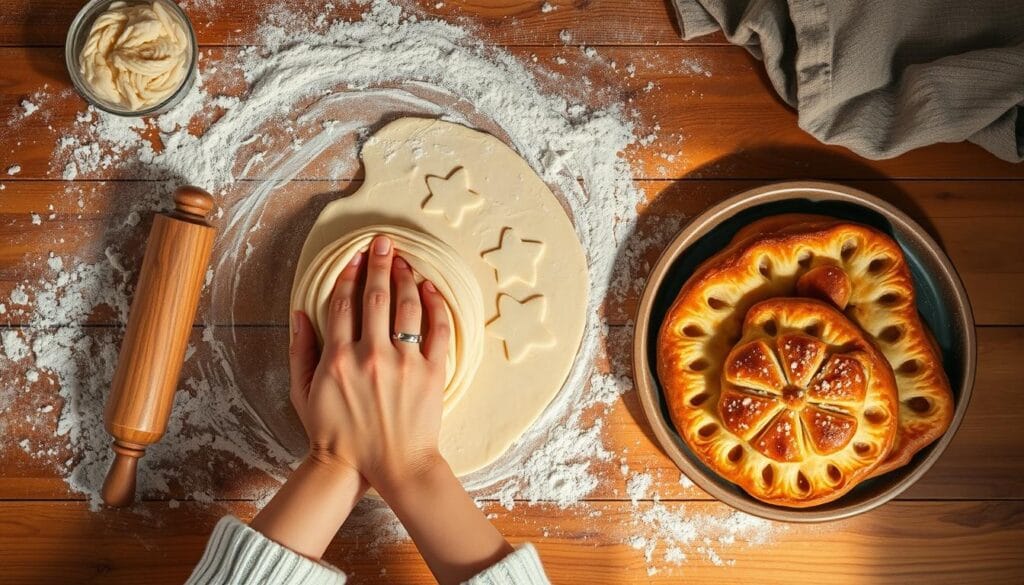The smell of fresh pastries takes you straight to the Swiss Alps. Every morning, the Swiss enjoy the crunchy gipfeli. As a home baker, making these Swiss croissants is a journey into European breakfast traditions.
With your homemade gipfeli recipe, your kitchen becomes a Swiss bakery. Unlike French croissants, Swiss gipfeli have a unique texture and taste. It’s a surprise for your taste buds.
Though making Swiss pastry seems hard, the right ingredients and technique make it easy. You’ll make croissants that wow your loved ones.
Key Takeaways
- Learn the authentic Swiss gipfeli recipe from scratch
- Understand the unique differences between gipfeli and French croissants
- Master the art of creating flaky, buttery pastry layers
- Discover professional baking techniques for perfect results
- Enjoy a true taste of Swiss culinary tradition
Understanding Swiss Gipfeli: A Croissant’s Alpine Cousin
Swiss pastry traditions bring us a delightful treasure: the gipfeli. This Swiss pastry is a distant cousin of the French croissant. Yet, it has its own unique taste and identity.
Origins and Cultural Significance
The swiss gipfeli comes from the Austrian “Kipferl”. It became a key Swiss breakfast item. Swiss bakers made it their own, showing off the country’s baking traditions.
Differences Between Gipfeli and French Croissants
Comparing gipfeli to French croissants shows interesting differences. Gipfeli are known for:
- More compact shape
- Denser texture
- Slightly sweeter taste
- Higher milk content
| Characteristic | Gipfeli | French Croissant |
|---|---|---|
| Butter Content | Lower | Higher |
| Milk Content | Higher | Lower |
| Texture | Softer | Flakier |
Traditional Consumption Habits in Switzerland
Swiss people love gipfeli in the morning. They enjoy them with café au lait, tea, or milk. They often pair them with:
- Homemade fruit jam
- Local honey
- Artisan cheese
- Butter spreads
“A gipfeli is not just a pastry, it’s a slice of Swiss morning tradition.”
Swiss bakeries make fresh gipfeli every morning. They want to give their customers the best taste and texture.
Essential Ingredients for Authentic Gipfeli Recipe
To make authentic Swiss gipfeli, you need top-notch ingredients. These ingredients are the heart of a delicious baked goods recipe. They bring the taste of Switzerland right to your kitchen.
Understanding the exact ingredients is key to making gipfeli. Unlike regular croissants, gipfeli need special ingredients. These ingredients give them their unique texture and taste.
Primary Ingredients for Classic Gipfeli
- High-quality all-purpose flour (500g)
- Cold unsalted butter with 82% fat content (250-300g)
- Active dry yeast (7g)
- Granulated sugar (50g)
- Fine salt (10g)
- Warm whole milk (250-280ml)
- Egg for brushing
Optional Flavor Enhancers
- Dark chocolate pieces
- Poppy or sesame seeds
- Almond paste
- Orange zest
Choosing the right ingredients is crucial. Professional bakers suggest using bread flour for a chewier texture. But, all-purpose flour is great for home bakers.
“The secret to perfect gipfeli is in the quality of your ingredients and the precision of your technique.” – Swiss Baking Tradition
| Ingredient | Quantity | Purpose |
|---|---|---|
| All-Purpose Flour | 500g | Provides structure |
| Cold Unsalted Butter | 300g | Creates flaky layers |
| Active Dry Yeast | 7g | Enables dough rising |
Each ingredient is vital in making an amazing Swiss pastry. Paying attention to ingredient quality is what makes your gipfeli special.
Required Kitchen Tools and Equipment
To make delicious Gipfeli, you need the right baking tools. The right equipment can turn a good pastry into an amazing Swiss croissant. Let’s look at the tools you’ll need to make these tasty treats.
Basic Baking Equipment You Can’t Skip
Every Gipfeli baker needs these basic kitchen tools:
- Sturdy mixing bowls in various sizes
- Precise measuring cups and spoons
- Long rolling pin for even dough preparation
- Quality baking sheet with even heat distribution
- Parchment paper for non-stick baking
- Soft pastry brush for egg washing
Optional Tools to Elevate Your Pastry Game
These tools are not essential but can enhance your baking:
- Silicone baking mat for consistent results
- Pizza cutter for precise dough shaping
- Pastry scraper for handling delicate dough
“The right tools can turn a good baker into a great one.” – Swiss Baking Tradition
Temperature Control Essentials
Pastry-making requires precision. Invest in reliable thermometers for accurate temperatures:
- Oven thermometer for accurate baking temperatures
- Refrigerator thermometer to ensure proper dough resting
- Digital instant-read thermometer for ingredient temperatures
Having the right baking equipment can greatly improve your Gipfeli’s texture and taste. Take the time to gather these tools. You’ll be well on your way to making authentic Swiss croissants.
Mastering the Dough Preparation
Making the perfect gipfeli dough needs care and patience. Start by picking top-notch ingredients and learning how to work with yeast. The secret to great Swiss croissants is in the right mix of ingredients and skills.

- French Type 55 flour
- Whole milk
- Unsalted butter
- Instant yeast
- Sugar
- Salt
“The secret to perfect gipfeli is in the details of dough preparation.”
Here’s how to make your yeast dough:
- Mix dry ingredients well
- Dissolve yeast in warm milk (25-30°C)
- Combine wet and dry ingredients carefully
- Knead for 8-10 minutes until smooth
| Dough Preparation Stage | Temperature | Time |
|---|---|---|
| Initial Mixing | Room temperature (below 20°C) | 15 minutes max |
| Resting Period | Refrigerator | 20-30 minutes |
| Overnight Rest | Refrigerator | 12 hours minimum |
Pro tip: Keep cool temperatures to get the right dough texture and taste. The room should be under 20°C (68°F) to keep butter right and prevent dough from rising too soon.
Let your dough rest in the fridge overnight. This lets flavors grow and gluten relax. It’s key for making the best Swiss croissants at home.
The Art of Lamination: Creating Perfect Layers
Pastry lamination is the secret to flaky gipfeli that melt in your mouth. It turns simple ingredients into a culinary masterpiece. This is done by creating layers of butter and dough.
The flaky pastry technique needs precision and patience. Your success depends on managing temperature and technique carefully.
Cold Butter Technique
Butter layering starts with the right butter. Professional bakers choose European-style butter with 82-86% butterfat content. Your butter block should be clay-like – malleable but not greasy.
- Use high-quality butter brands like Plugra or Vermont Creamery
- Maintain butter temperature between 52-61°F
- Ensure butter is cold but pliable
Folding Methods for Flaky Texture
Creating layers needs specific folding techniques. The classic method involves:
- Rolling dough into a 24 x 12-inch rectangle
- Placing cold butter in the center
- Folding dough like an envelope
- Performing a single fold (thirds)
Resting Times and Temperature Control
Proper chilling between folds is key for flaky layers. Chill your dough in the refrigerator at 36-43°F. This relaxes gluten and keeps layers intact.
“Precision is the heart of successful lamination.” – Professional Pastry Chef
| Stage | Temperature | Duration |
|---|---|---|
| Butter Block | 52-61°F | Before lamination |
| Dough | 36-43°F | Between folds |
| Proofing | 75-78°F | 2-3 hours |
Mastering pastry lamination takes practice. Stay patient and enjoy the delicious learning process!
Shaping and Rolling Techniques

Learning to shape gipfeli is an art that turns your dough into Swiss croissants. It needs precision and patience to get the Alpine pastry shape right.
Start by rolling the dough carefully. Use a measuring tape to keep it about 3mm thick. This is crucial for creating the flaky layers that make gipfeli special.
“The secret to beautiful gipfeli lies in the delicate dance of dough and technique.”
Here are the key steps for shaping gipfeli:
- Roll the dough to a uniform 3mm thickness
- Cut triangular shapes with a 4-inch base and 6-inch height
- For filled versions, place your filling at the triangle’s base
- Gently roll from the base to the tip, creating a smooth crescent
- Tuck the tip underneath to prevent unrolling during baking
Pro tip: Cold dough is easier to handle, so work quickly and keep your surface lightly floured to prevent sticking.
Focus on the final shape. A well-shaped gipfeli has a smooth curve that shows off the tasty layers inside. With practice, you’ll get better at making pastries that look like they came from a bakery.
Proofing and Baking Guidelines
Mastering pastry proofing is key to baking gipfeli. It turns raw dough into a light, airy Swiss pastry. This will wow even the pickiest bakers.
Optimal Proofing Conditions
Getting the right proofing environment is crucial for perfect gipfeli. Your space should have:
- Temperature: Keep it at 82°F (28°C) consistently
- Humidity: Aim for 85% relative humidity
- Resting time: Give it 1-2 hours for full proofing
Temperature and Timing Tips
Being precise with temperature and timing is vital. Here are some tips from experts:
| Stage | Temperature | Duration |
|---|---|---|
| Initial Proofing | 82°F (28°C) | 1-2 hours |
| Oven Preheating | 390°F (200°C) | 15-20 minutes |
| Baking | 375°F (190°C) | 18-22 minutes |
Visual Cues for Perfect Baking
Spotting when your gipfeli are done needs sharp eyes. Look for these signs:
- Slight puffiness shows it’s risen right
- Golden-brown outside with even color
- Crisp edges and soft, chewy inside
“The art of baking gipfeli lies in patience and precision.” – Swiss Baking Tradition
Remember, practice is key. Every batch of gipfeli you make will improve your skills. You’ll get better at pastry proofing.
Troubleshooting Common Baking Issues
Mastering gipfeli troubleshooting means knowing common pastry problems and how to fix them. Most home bakers face issues that can be solved with the right techniques.
“Perfect pastries are born from patient problem-solving and precise techniques.”
Working with gipfeli dough can lead to several critical issues. These problems affect the final product’s quality. Let’s look at the most common challenges and their expert solutions:
- Lack of Flakiness: Keep butter cold during lamination. Warm butter can ruin the delicate layers.
- Sticky Dough: Add flour slowly to get the right consistency without overworking.
- Poor Rising: Check if your yeast is fresh and keep the proofing temperature between 76°F to 79°F.
- Uneven Baking: Rotate the baking sheet halfway through cooking.
Knowing the quality of your ingredients is key for making great gipfeli. Here are some important factors to consider:
| Ingredient | Recommended Specification |
|---|---|
| Flour Protein Content | 12.5% protein |
| Butter Butterfat | 82-84% |
| Yeast Type | Red Star Active Dry Yeast |
| Proofing Temperature | 77°F |
Pro tip: About 75% of first-time bakers need 3-4 tries to get their gipfeli right. Don’t give up—each batch is a chance to learn more about pastry making.
Storage and Reheating Methods
Keeping your homemade gipfeli fresh is key. You need to know how to store and reheat them right. This way, you can enjoy these Swiss pastries at their best.
Proper Storage Techniques
Let your gipfeli cool down completely before storing. For a short time, put them in an airtight container. They stay fresh for 1-2 days at room temperature.
- Store in a sealed container
- Keep at room temperature
- Consume within 48 hours
Refrigeration and Freezing Guidelines
Gipfeli freeze well. Wrap each one in plastic wrap and then in a freezer-safe bag. They can stay frozen for up to 2 months.
| Storage Method | Duration | Recommended Approach |
|---|---|---|
| Room Temperature | 1-2 days | Airtight container |
| Refrigerator | 5-7 days | Sealed container |
| Freezer | Up to 2 months | Individually wrapped |
Reheating Pastries Like a Pro
To reheat gipfeli, use gentle heat. This keeps them crispy on the outside and soft inside. The oven is the best way to do this.
- Preheat oven to 300°F (150°C)
- Let frozen gipfeli thaw for 15-20 minutes
- Place on a baking sheet
- Warm for 5-7 minutes
Pro tip: Avoid microwaving, as it can make your gipfeli soggy and compromise their delicate texture.
By using these storage and reheating tips, your gipfeli will stay delicious. They’ll taste just as good as when they were first baked.
Serving Suggestions and Pairings
Your freshly baked Swiss gipfeli deserve a perfect presentation. This elevates your swiss breakfast experience. These delicate pastries offer versatile serving options. They can transform your morning routine into a culinary delight.
- Serve warm with high-quality butter and artisanal jam
- Pair with rich Swiss coffee or herbal tea
- Create savory versions with light protein toppings
- Experiment with creative filling combinations
For a traditional swiss breakfast, consider these pastry pairings. They complement your gipfeli:
| Beverage | Recommended Pairing |
|---|---|
| Hot Chocolate | Plain butter gipfeli |
| Espresso | Nutella-filled gipfeli |
| Herbal Tea | Jam-topped gipfeli |
Innovative filling options can transform your gipfeli. Try smoked salmon with cream cheese, Nutella spread, or herb-infused soft cheese. These offer unexpected flavor combinations.
“A well-served gipfeli is not just a pastry, but a morning ritual.” – Swiss Culinary Tradition
Remember, gipfeli are best enjoyed fresh and warm. Your creativity can turn these Swiss pastries into a memorable breakfast or brunch centerpiece.
Conclusion
Your adventure in Swiss baking reaches its peak with homemade Gipfeli. With patience and practice, you’ll master pastry making. This turns simple ingredients into tasty Swiss pastries.
The secret is knowing how to balance technique, temperature, and ingredients. Each Gipfeli you make tells a story of culinary tradition. From kneading the dough to butter lamination, you’re preserving Swiss heritage.
Try different fillings like chocolate, almond paste, or savory options. This makes your recipe truly yours. Remember, mastering Gipfeli takes time.
Your first tries might not be perfect, but each batch gets better. The flaky texture and subtle flavor are worth the effort. With more practice, your Gipfeli will be as good as those in Swiss bakeries.
Enjoy the journey of making these delightful pastries. Serve them with morning coffee or as an afternoon treat. Your homemade Gipfeli will become a favorite in your kitchen. Learn, bake, and share these delicious Swiss croissants with your loved ones.
Table of Contents
FAQ
What is the difference between Gipfeli and a traditional French croissant?
Can I make Gipfeli with different fillings?
How long can I store homemade Gipfeli?
What type of flour works best for Gipfeli?
Why is butter temperature so important in making Gipfeli?
Is making Gipfeli difficult for home bakers?
What are the best ways to serve Gipfeli?
Can I make Gipfeli without a stand mixer?
Leave us a comment if you like the recipe
There are no reviews yet. Be the first one to write one.
